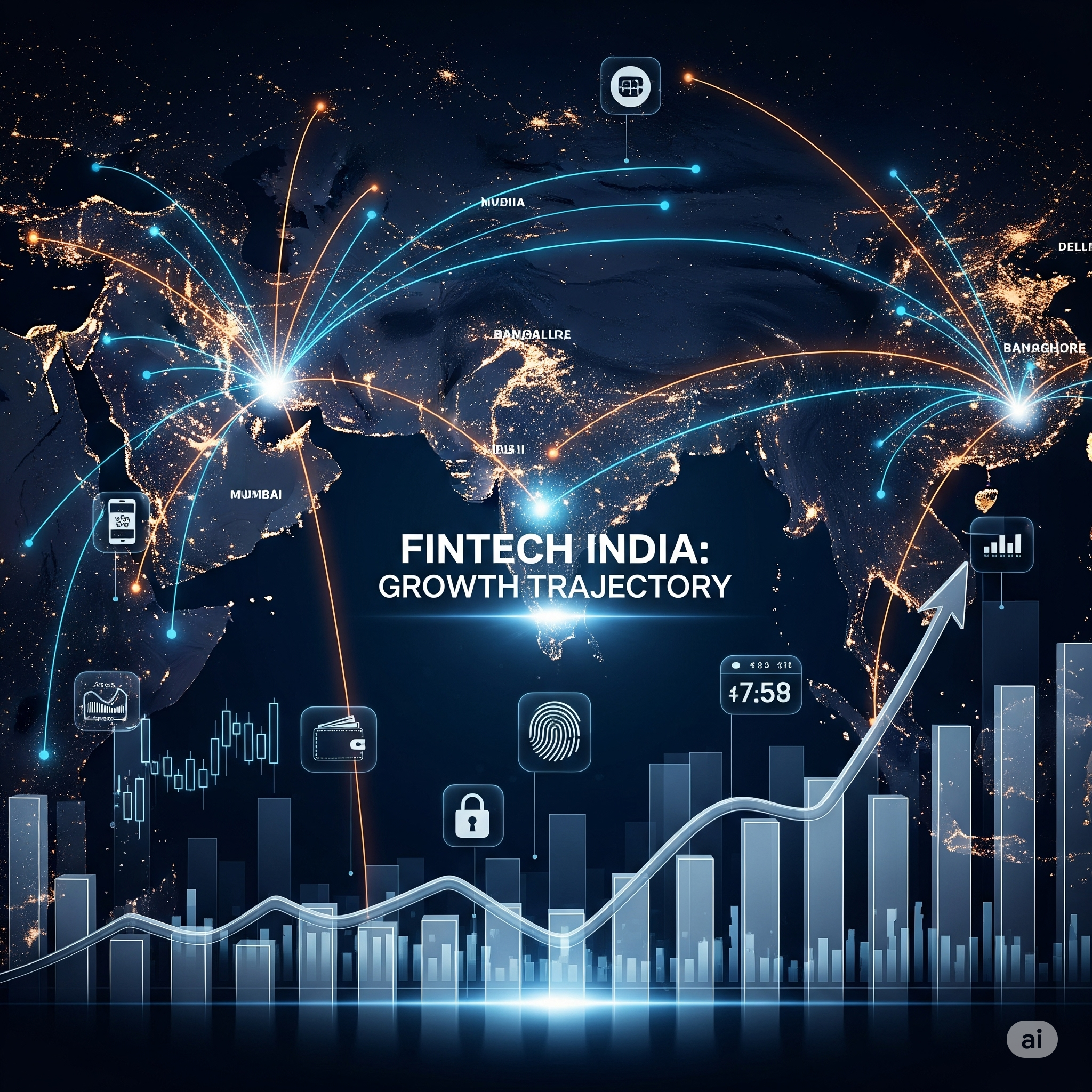Introduction
Over the last decade, India has witnessed a financial revolution fueled by technology. Financial Technology, or FinTech, refers to the innovative use of digital tools and modern technology in delivering financial services. From mobile banking and digital wallets to peer-to-peer lending and blockchain solutions, FinTech has reshaped how individuals, businesses, and governments manage money.
India, with its vast population, growing internet penetration, and supportive policy environment, has become one of the fastest-growing FinTech hubs in the world. The Indian FinTech market is not just an urban phenomenon but is rapidly expanding into rural areas, promoting financial inclusion and bridging the gap between traditional banking and underserved populations.
This article explores the growth of FinTech in India, its drivers, segments, regulatory framework, challenges, and the way forward for this booming sector.
Understanding FinTech
FinTech combines finance and technology to make financial services more efficient, inclusive, and customer-centric. It covers a wide range of services, such as:
- Digital Payments (UPI, wallets, mobile banking)
- Lending and Credit Platforms (peer-to-peer lending, digital loans)
- WealthTech (robo-advisors, digital investment platforms)
- InsurTech (technology-driven insurance solutions)
- RegTech (regulatory technology for compliance and monitoring)
- Blockchain and Cryptocurrencies
- Neobanking (digital-only banks)
Growth Trajectory of FinTech in India
1. Early Stages (2005–2010)
- Introduction of online banking and net banking.
- Emergence of early payment gateways like BillDesk.
- Limited to urban and tech-savvy customers.
2. Expansion Era (2011–2015)
- Launch of smartphones and cheap data fueled adoption.
- Digital wallets like Paytm, Freecharge, and Mobikwik gained popularity.
- Government initiatives such as Aadhaar and Jan Dhan Yojana laid the foundation for digital financial inclusion.
3. Post-Demonetization Boom (2016–2019)
- Demonetization in 2016 acted as a catalyst for digital payments.
- Introduction of Unified Payments Interface (UPI) revolutionized transactions.
- Rise of digital lending, insurance, and investment apps.
- Venture capital and global investors started pouring money into Indian FinTech.
4. COVID-19 and Beyond (2020–Present)
- Pandemic accelerated digital adoption as people avoided cash.
- Surge in demand for contactless payments, digital loans, and online investment platforms.
- India emerged as the world’s largest real-time payments market, accounting for nearly half of global digital transactions (as per NPCI reports).
- Rapid growth of neobanks, Buy Now Pay Later (BNPL), and InsurTech platforms.
Drivers of FinTech Growth in India
- Government Policies and Initiatives
- Digital India Mission promoting e-governance and financial literacy.
- Jan Dhan-Aadhaar-Mobile (JAM) Trinity enabling financial inclusion.
- UPI, BHIM App, and RuPay cards launched under government support.
- Internet and Smartphone Penetration
- Over 800 million smartphone users and one of the cheapest internet data rates in the world.
- Enabled even rural populations to access digital financial services.
- Demonetization (2016)
- Pushed millions towards cashless transactions overnight.
- Boosted platforms like Paytm, PhonePe, and Google Pay.
- COVID-19 Pandemic
- Increased reliance on online shopping, digital payments, and remote banking.
- Accelerated adoption of contactless transactions.
- Investment and Start-up Ecosystem
- India is home to over 3000 FinTech start-ups.
- Significant investments from global venture capitalists and private equity firms.
- Financial Inclusion Needs
- Large sections of the population were unbanked or underbanked.
- FinTech helped bridge the gap by reaching areas where traditional banks struggled.
Key Segments of FinTech in India
1. Digital Payments
- UPI, PhonePe, Paytm, Google Pay dominate this space.
- India recorded 100 billion UPI transactions in 2023 alone.
- Contactless QR-code-based payments transformed street vendors and small businesses.
2. Digital Lending
- Instant loans through apps and platforms like LendingKart, KreditBee, and Paytm Credit.
- MSMEs benefit from quick credit approvals and minimal paperwork.
3. WealthTech
- Platforms like Zerodha, Groww, and Upstox made investing easy for retail investors.
- Robo-advisors and AI-driven portfolio managers gained traction.
4. InsurTech
- Companies like PolicyBazaar, Acko, and Digit Insurance disrupted traditional insurance with online products.
- Personalized, usage-based insurance is gaining ground.
5. Neobanking
- FinTech companies like Fi, Jupiter, and Niyo provide banking services without physical branches.
- Targeting millennials and SMEs with tech-driven services.
6. Blockchain and Cryptocurrencies
- Increasing interest in blockchain-based solutions.
- Crypto adoption in India remains high despite regulatory uncertainties.
7. RegTech
- Automating compliance, fraud detection, and KYC verification.
- Helps financial institutions meet regulatory standards efficiently.
Regulatory and Policy Landscape
India’s regulatory environment has played a pivotal role:
- Reserve Bank of India (RBI) – Oversees digital lending, payments, and neobanking.
- Securities and Exchange Board of India (SEBI) – Regulates digital investment platforms.
- Insurance Regulatory and Development Authority of India (IRDAI) – Supervises InsurTech.
- Ministry of Electronics and IT (MeitY) – Supports Digital India and UPI ecosystem.
- Data Protection Bill (in progress) – Aims to regulate data privacy in digital finance.
Challenges Facing FinTech Growth in India
- Cybersecurity Risks – Increasing fraud, hacking, and phishing attacks.
- Regulatory Uncertainty – Lack of clarity on cryptocurrencies and digital lending norms.
- Digital Divide – Rural areas still face connectivity and literacy issues.
- Consumer Awareness – Many users lack knowledge about digital safety.
- Competition with Traditional Banks – Collaboration vs. competition remains a challenge.
- High NPAs in Digital Lending – Rising defaults due to instant and unsecured loans.
Impact of FinTech in India
Economic Impact
- Boosted GDP contribution through innovation.
- Enhanced ease of doing business for MSMEs.
- Attracted global investors and created jobs.
Social Impact
- Financial inclusion for millions of unbanked citizens.
- Empowered women and rural entrepreneurs.
- Reduced dependency on cash, making transactions safer.
Technological Impact
- Integration of AI, ML, and blockchain into financial systems.
- Growth of secure, scalable digital infrastructures like UPI.
Case Studies
- UPI Success Story
- Unified Payments Interface revolutionized India’s payment system.
- Handled 8 billion+ transactions monthly in 2023.
- Paytm and Digital Wallets
- From a mobile recharge platform to India’s largest digital payments ecosystem.
- Expanded into lending, insurance, and wealth management.
- Zerodha in WealthTech
- A discount brokerage firm transformed the stock trading landscape.
- Encouraged millions of retail investors to participate in the stock market.
- PolicyBazaar in InsurTech
- Digital platform simplifying insurance comparisons and purchases.
- Increased transparency and accessibility in the insurance sector.
The Future of FinTech in India
- Artificial Intelligence and Machine Learning
- Smarter credit scoring, fraud detection, and personalized services.
- Smarter credit scoring, fraud detection, and personalized services.
- Blockchain Adoption
- Potential to transform supply chains, identity management, and cross-border payments.
- Potential to transform supply chains, identity management, and cross-border payments.
- Expansion in Rural Areas
- Targeting 65% of India’s population still underserved by banks.
- Targeting 65% of India’s population still underserved by banks.
- Green and Sustainable FinTech
- Financing renewable energy projects and sustainable enterprises.
- Financing renewable energy projects and sustainable enterprises.
- Stronger Regulations
- A balanced framework ensuring innovation while safeguarding consumers.
- A balanced framework ensuring innovation while safeguarding consumers.
- Collaboration Between Banks and FinTech
- Hybrid models combining trust of traditional banks with agility of FinTech start-ups.
Conclusion
The growth of FinTech in India is nothing short of revolutionary. It has disrupted traditional banking, brought millions into the formal financial system, and created an ecosystem that fosters innovation and inclusion. With government support, technological advancements, and growing consumer demand, India is set to remain at the forefront of global FinTech growth.
However, challenges such as cybersecurity, regulatory clarity, and digital literacy must be addressed to ensure sustainable and inclusive growth. FinTech in India is not just about convenience—it is about reshaping the financial future of a nation.




